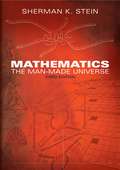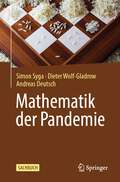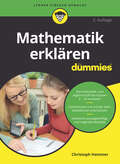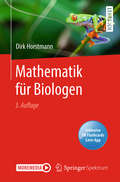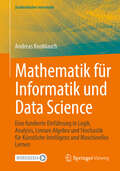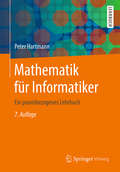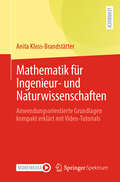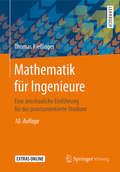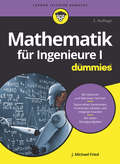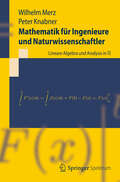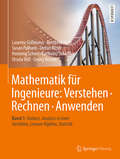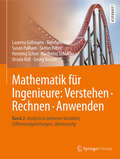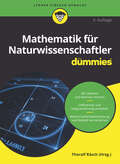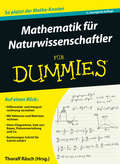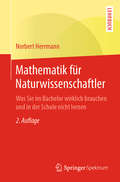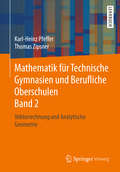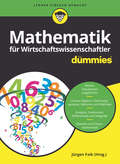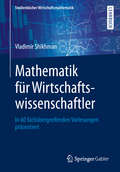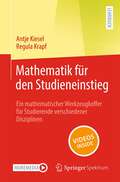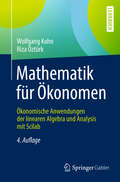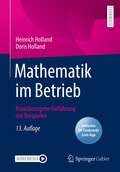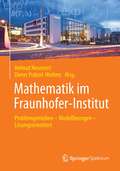- Table View
- List View
Mathematics: The Easy Way to Learn Maths
by Hugh Neill Trevor JohnsonMaths does not have to be difficult. This book, complete with exercises and answers, forms a course which will take you from beginner or intermediate level to being a confident mathematician. This book includes: simple step-by-step explanations, to help you grasp new topics or those that have previously confused you; practice questions throughout, to help you embed your learning and improve your confidence; and end of chapter summaries, to help you remember the key points you've learned - all in one great-value book, so you don't need any separate workbooks or coursebooks.Chapters include: number; angles; fractions; two-dimensional shapes; decimals; statisticsl directed numbers; graphs; measurement; perimeter and area; algebraic expressions; approximations; equations; percentages; formulae; circles; probability; three-dimensional shapes; ratio and proportion; pythagoras' theorem and trigonometry; indices and standard form.ABOUT THE SERIESThe Complete Introduction series from Teach Yourself is the ultimate one-stop guide for anyone wanting a comprehensive and accessible entry point into subjects as diverse as philosophy, mathematics, psychology, Shakespeare and practical electronics. Loved by students and perfect for general readers who simply want to learn more about the world around them, these books are your first choice for discovering something new.
Mathematics: The Man-made Universe (Dover Books on Mathematics)
by Sherman K. SteinAnyone can appreciate the beauty, depth, and vitality of mathematics with the help of this highly readable text, specially developed from a college course designed to appeal to students in a variety of fields. Readers with little mathematical background are exposed to a broad range of subjects chosen from number theory, topology, set theory, geometry, algebra, and analysis. Starting with a survey of questions on weight, the text discusses the primes, the fundamental theorem of arithmetic, rationals and irrationals, tiling, tiling and electricity, probability, infinite sets, and many other topics. Each subject illustrates a significant idea and lends itself easily to experiments and problems. Useful appendices offer an overview of the basic ideas of arithmetic, the rudiments of algebra, suggestions on teaching mathematics, and much more, including answers and comments for selected exercises.
Mathematik der Pandemie
by Andreas Deutsch Dieter Wolf-Gladrow Simon SygaDie COVID-19-Pandemie hat weltweit dramatische Folgen. Mathematische Modelle spielen bei ihrer Bewertung eine zentrale Rolle: Sie sollen die Wirkung von Maßnahmen abschätzen, die oft mit Einschränkungen individueller Freiheiten einhergehen. Umso mehr sollte das Wissen um die Mathematik der Pandemie nicht nur Experten überlassen bleiben. Dieses Buch erläutert grundlegende Begriffe und Modelle, und klärt weitverbreitete Missverständnisse auf. Das Buch gibt insbesondere Antwort auf folgende Fragen:Was sagen Kennzahlen wie Inzidenz, Reproduktionszahl, Hospitalisierungsrate oder Impfquote über die Pandemie?Was ist der Unterschied von linearem und exponentiellem Wachstum?Was ist Herdenimmunität? Warum werden sich trotz Herdenimmunität fast alle Ungeimpften anstecken?Was ist der Effekt von Kontaktbeschränkungen und Impfung?Warum sind Vorhersagen in der Pandemie schwierig?
Mathematik erklären für Dummies (Für Dummies)
by Christoph HammerWenn sich ein Kind im Matheunterricht schwertut, sind gute Erklärungen gefragt. Sei es von Eltern, Großeltern, Freunden oder Nachhilfelehrern. Diese Neuauflage von "Mathe für Eltern für Dummies" bereitet wesentliche Themen aus den Klassen 5-10 verständlich auf: vom Bruchrechnen über Variablen, Gleichungen und Funktionen bis hin zu Sachaufgaben. Zahlreiche Beispiele und Abbildungen vermitteln Vorstellungen von dem, was abstrakte Formeln ausdrücken wollen. Ein spezielles Symbol erscheint immer dann im Buch, wenn es um typische Stolpersteine geht. Entwickeln Sie gemeinsam Freude an der Mathematik, denn Begeisterung steckt an!
Mathematik für Biologen
by Dirk HorstmannDieses vierfarbige Kurzlehrbuch konzentriert sich auf die Mathematik-Curricula der Bachelorstudiengänge Biologie. Neben der Vermittlung des mathematischen Grundwissens stellt es den Bezug zu den zugrunde liegenden biologischen Fragestellungen her. Konkrete Beispiele bzw. wissenswerte Zusatzinformationen zu historischen Personen/Wissenschaftlern werden gegeben.Die Themen des Buches sind „chronologisch" aufeinander aufgebaut. Das einleitende Kapitel beschäftigt sich mit möglichen grafischen Darstellungsmöglichkeiten experimentell erhobener Daten. Hier werden bereits erste „stochastische / statistische" Begriffe eingeführt, die in den weiteren Kapiteln im Zusammenhang mit dem Thema Wahrscheinlichkeitsverteilungen und Zufallsvariablen erneut auftauchen.Die zweite Auflage wurde um zusätzliche Anmerkungen zur Fehlerrechnung ergänzt und durch ein Kapitel zu Differenzengleichungen sowie eine Formelsammlung der wichtigsten Formeln und Rechenvorschriften der in dem Buch behandelten Themen erweitert. Neben seiner Einsatzmöglichkeit als Lehr- und Lernmaterial für Studierende und Dozenten kann das Buch auch als ein Nachschlagwerk verwendet werden, das die behandelte Mathematik mit Namen und Sachthemen aus dem Studium oder dem alltäglichen Leben in Verbindung bringt. Hierdurch soll die bei vielen Studierenden existierende „Denkblockade" beiseite geräumt und klar gemacht werden, dass Mathematik in den Lebenswissenschaften eindeutig mehr ist, als die bloße Anwendung von statistischen Methoden.
Mathematik für Hochschule und duales Studium
by Guido WalzDieses Buch führt Sie auf leicht verständliche Weise von den gängigen Bereichen der Linearen Algebra und Analysis bis hin zur Stochastik und Numerik. Es ist in einem unverkrampften und ermutigenden, bisweilen sogar unterhaltsamen Stil geschrieben, der das Lesen leicht macht – ohne es jedoch an der nötigen Exaktheit und Präzision fehlen zu lassen. Viele ausführliche Erklärungen und Beispiele sowie zahlreiche Übungsaufgaben mit Lösungen unterstützen beim Lernen und helfen beim Verstehen des Stoffes – so dass Sie in jede Prüfung mit dem sicheren Gefühl gehen können: „Das kann ich!“Im Rahmen der 3. Auflage wurde das Buch ergänzt durch den kostenlosen Zugang zur Springer Nature Flashcards-App. Hier wird dem Leser exklusives Zusatzmaterial in Form von über 300 neuen Prüfungsfragen zur Verfügung gestellt, mit deren Hilfe man jederzeit den eigenen Leistungsstand ermitteln und Prüfungssimulationen durchführen kann.
Mathematik für Informatik und Data Science: Eine fundierte Einführung in Logik, Analysis, Lineare Algebra und Stochastik für Künstliche Intelligenz und Maschinelles Lernen (Studienbücher Informatik)
by Andreas KnoblauchDieses Buch liefert eine kompakte aber fundierte Darstellung der wichtigsten Gebiete der Mathematik für Informatik, die insbesondere für Data Science, Künstliche Intelligenz und Maschinelles Lernen notwendig sind. Inhaltlich gehören dazu Grundlagen zu Logik und Beweisen, ein- und mehrdimensionale Analysis mit Differential- und Integralrechnung, Lineare Algebra mit Vektor- und Matrixrechnung, linearen Gleichungssystemen, Koordinatentransformationen, Eigenvektoren sowie Wahrscheinlichkeitsrechnung mit Grundlagen der Kombinatorik, Statistik und Informationstheorie. Trotz der kompakten Darstellung werden alle Konzepte und Sätze sorgfältig eingeführt und bewiesen. Nichts soll vom Himmel fallen, sondern aus Axiomen und elementaren Prinzipien hergeleitet werden. Ziel ist es beim Studierenden das befriedigende Gefühl zu erzeugen, alles von Grund auf verstanden zu haben, und nichts nur „glauben“ zu müssen.
Mathematik für Informatiker: Ein praxisbezogenes Lehrbuch
by Peter HartmannDieses Buch enthält den Mathematikstoff, der für das Informatikstudium in anwendungsorientierten Bachelorstudiengängen benötigt wird. Der Inhalt entspringt der langjährigen Lehrerfahrung des Autors.Das heißt:Sie finden immer wieder Anwendungen aus der Informatik.Sie lernen nicht nur mathematische Methoden, es werden auch die Denkweisen der Mathematik vermittelt, die eine Grundlage zum Verständnis der Informatik bilden.Beweise werden dann geführt, wenn Sie daraus etwas lernen können, nicht um des Beweisens willen.Mathematik ist für viele Studierende zunächst ein notwendiges Übel. Das Buch zeigt durch ausführliche Motivation, durch viele Beispiele, durch das ständige Aufzeigen von Querbezügen zwischen Mathematik und Informatik, dass Mathematik nicht nur nützlich ist, sondern interessant sein kann und manchmal auch Spaß macht.
Mathematik für Ingenieur- und Naturwissenschaften: Anwendungsorientierte Grundlagen kompakt erklärt mit Video-Tutorials
by Anita Kloss-BrandstätterDieses innovative Video-Lehrbuch ist ein kompakter Begleiter für alle, die mathematische Grundlagen schnell erfassen und sicher anwenden möchten – insbesondere für Studierende der Natur- und Ingenieurwissenschaften. Das Buch verbindet kompakte Wissensvermittlung mit praxisnahen Anwendungen und einem direkten Zugang zu ausführlichen Video-Tutorials im YouTube-Kanal der Autorin („Sciencebarbie erklärt Mathematik&“). Mit klarer Struktur und prägnanter Darstellung bietet es den perfekten Einstieg in die Welt der höheren Mathematik, ohne dabei den Fokus auf das Wesentliche zu verlieren: die Anwendung. Praktische Beispiele und reale Problemstellungen stehen im Mittelpunkt, während der theoretische Hintergrund auf das Notwendige reduziert ist. Durch anschauliche Schritt-für-Schritt-Erklärungen in den Videos werden selbst komplexe Themen leicht verständlich. Ob im Studium, zur Prüfungsvorbereitung oder für die Anwendung im Berufsalltag – dieses Buch bietet eine flexible und effiziente Möglichkeit, die anwendungsorientierten Grundlagen der Mathematik wirklich zu durchdringen.
Mathematik für Ingenieure
by Thomas Rießinger"Mathematik in entspannter Atmosphäre" ist das Leitbild dieses leicht verständlichen Lehrbuchs. Im Erzählstil und mit vielen Beispielen beleuchtet der Autor nicht nur die Höhere Mathematik, sondern er stellt auch den Lehrstoff in Bezug zu den Anwendungen. Die gesamte für den Ingenieurstudenten wichtige Mathematik wird in einem Band behandelt. Dies gelingt durch Verzicht auf abstrakte Höhen und durch eine prüfungsgerechte Stoffauswahl, die sich streng an den Bedürfnissen des späteren Ingenieurs ausrichtet. Das Buch kann vorlesungsbegleitend oder zum Selbststudium eingesetzt werden. Die 159 Übungsaufgaben mit Lösungen unterstützen das Einüben des Lehrstoffs und sind im Band "Übungsaufgaben zur Mathematik für Ingenieure" ausführlich durchgerechnet.Der "Brückenkurs" beim Buch auf springer.com erleichtert Anfängern den Einstieg.
Mathematik für Ingenieure I für Dummies (Für Dummies)
by J. Michael FriedAlle Ingenieure benötigen sie - kaum einer mag sie eigentlich: die Mathematik. Aber Ingenieursmathematik muss nicht schwer verständlich sein, sie kann auch Spaß machen. J. Michael Fried vermittelt Ihnen in diesem Buch die Grundlagen der Mathematik, die alle Ingenieure in den ersten Semestern benötigen. Los geht's mit der Linearen Algebra: Lernen Sie, wie Sie mit Vektoren und Matrizen rechnen, lineare Gleichungssysteme lösen und Eigenwerte sowie Eigenvektoren berechnen. Außerdem führt der Autor Sie in die Geheimnisse der eindimensionalen Analysis ein und erklärt alles Wissenswerte zu Folgen und Grenzwerten, zur Differenzial- und zur Integralrechnung. Anhand von vielen Tipps und Praxisbeispielen lernen Sie, wo die erworbenen Kenntnisse in den Ingenieurwissenschaften angewendet werden. Mit Übungsaufgaben und ausführlichen Lösungen können Sie Ihr Wissen auch gleich noch überprüfen und festigen. Dieses Buch richtet sich an Studierende aller Ingenieurwissenschaften - sowohl zum Lernen als auch zum Nachschlagen.
Mathematik für Ingenieure und Naturwissenschaftler
by Wilhelm Merz Peter KnabnerBasierend auf jahrzehntelanger Lehrerfahrung an der Universität Erlangen, bietet das Buch alle Mathematik-Themen, die für Ingenieure in den ersten beiden Semestern an deutschen Universitäten relevant sind: Lineare Algebra und Analysis in einer Raumdimension. Alle Aspekte sind detailliert und anhand kreativer und teils ausgefallener Beispiele dargestellt. Da die meisten Aussagen mit einer Beweisidee versehen sind, ist der Band auch für Lehramtsstudierende (Bachelor) geeignet. Begleitendes Übungsmaterial ist als Video im Internet verfügbar.
Mathematik für Ingenieure: Eine anschauliche Einführung für das praxisorientierte Studium
by Thomas Rießinger"Mathematik in entspannter Atmosphäre" ist das Leitbild dieses leicht verständlichen Lehrbuchs. Im Erzählstil und mit vielen Beispielen beleuchtet der Autor nicht nur die Höhere Mathematik, sondern er stellt auch den Lehrstoff in Bezug zu den Anwendungen. Die gesamte für den Ingenieurstudenten wichtige Mathematik wird in einem Band behandelt. Dies gelingt durch Verzicht auf abstrakte Höhen und durch eine prüfungsgerechte Stoffauswahl, die sich streng an den Bedürfnissen des späteren Ingenieurs ausrichtet. Das Buch kann vorlesungsbegleitend oder zum Selbststudium eingesetzt werden. Die 159 Übungsaufgaben mit Lösungen unterstützen das Einüben des Lehrstoffs und sind im Band "Übungsaufgaben zur Mathematik für Ingenieure" ausführlich durchgerechnet. Der "Brückenkurs" auf http://extras.springer.com/2013/978-3-642-36858-5 erleichtert Anfängern den Einstieg.
Mathematik für Ingenieure: Verstehen – Rechnen – Anwenden
by Susan Pulham Stefan Ritter Ursula Voß Karlheinz Schüffler Laurenz Göllmann Reinhold Hübl Henning Schon Georg VossenDieses zweibändige Werk stellt diejenigen Inhalte der Mathematik zusammen, welche die nachhaltige und sichere Anwendung der Methoden und Theorien in den technischen Ingenieurstudiengängen gewährleisten. Zudem erlernen Sie – geleitet durch zahlreiche Übungsaufgaben – allerlei nützliche Rechentechniken sowie eine Vielfalt an methodischen Herangehensweisen, auch unter Einsatz der Software Matlab. Wenn Sie sich auf das Erfolgsrezept des didaktischen Lernprinzips „Verstehen – Rechnen – Anwenden" einlassen, werden Sie sehen, dass Mathematik im Studium nicht nur bewältigt werden kann, sondern auch dazu beiträgt, technische Anwendungen tiefgründiger zu verstehen und Neues zu entwickeln. In diesem ersten Band werden zunächst alle nötigen Grundlagen dargestellt, wie sie oft in Vorkursen vermittelt werden. Danach folgt die Analysis, also die Differential- und Integralrechnung, in einer Variablen. Die Lineare Algebra behandelt insbesondere das Rechnen mit Vektoren und Matrizen. Schließlich bietet eine Einführung in die Statistik zahlreiche Methoden zur Analyse von Mess- und anderen Daten. Der vorliegende erste Band kann unabhängig von Band 2 gelesen werden, welcher die Themen Analysis in mehreren Variablen, Differenzialgleichungen und Optimierung enthält.
Mathematik für Ingenieure: Verstehen – Rechnen – Anwenden
by Susan Pulham Stefan Ritter Ursula Voß Karlheinz Schüffler Laurenz Göllmann Reinhold Hübl Henning Schon Georg VossenDieses zweibändige Werk stellt diejenigen Inhalte der Mathematik zusammen, welche die nachhaltige und sichere Anwendung der Methoden und Theorien in den technischen Ingenieurstudiengängen gewährleisten. Zudem erlernen Sie – geleitet durch zahlreiche Übungsaufgaben – allerlei nützliche Rechentechniken sowie eine Vielfalt an methodischen Herangehensweisen, auch unter Einsatz der Software Matlab.Wenn Sie sich auf das Erfolgsrezept des didaktischen Lernprinzips „Verstehen – Rechnen – Anwenden“ einlassen, werden Sie sehen, dass Mathematik im Studium nicht nur bewältigt werden kann, sondern auch dazu beiträgt, technische Anwendungen tiefgründiger zu verstehen und Neues zu entwickeln.In diesem zweiten Band wird zunächst die mehrdimensionale Analysis behandelt, d.h. die Differential- und Integralrechnung von (möglicherweise vektorwertigen) Funktionen in mehreren Variablen. Danach folgen gewöhnliche und partielle Differenzialgleichungen, die zur Modellierung zahlreicher technischer Phänomene gebraucht werden. Eine Einführung in die Optimierung bietet einen Einblick in mathematische Methoden zum Auffinden bestmöglicher Lösungen von ganz unterschiedlichen Fragestellungen. Der vorliegende zweite Band kann unabhängig von Band 1 gelesen werden, welcher die Themen Vorkurs, Analysis in einer Variablen, Lineare Algebra und Statistik enthält, sofern hinreichende Kenntnisse in dessen Grundlagenthemen vorhanden sind.
Mathematik für Naturwissenschaftler für Dummies (Für Dummies)
by Mark Ryan Deborah J. Rumsey Thoralf RäschMathematik muss nicht dröge und schwer verständlich sein, manchmal kann sie sogar ein bisschen Spaß machen. Thoralf Räsch vermittelt Ihnen die Grundlagen, die alle Naturwissenschaften benötigen: Algebra, Analysis, Differentiation, Integration, Differentialgleichungen, Lineare Algebra, Statistik, Wahrscheinlichkeitsrechnung und Hypothesentests. Anhand vieler Tipps und Praxisbeispiele lernen Sie, wie die erworbenen Kenntnisse in den Naturwissenschaften angewendet werden. Dieses Buch richtet sich an Studierende aller Naturwissenschaften ? sowohl zum Lernen als auch zum Nachschlagen.
Mathematik für Naturwissenschaftler für Dummies (Für Dummies)
by Thoralf RäschAlle Naturwissenschaftler benötigen sie, kaum einer mag sie: die Mathematik. Aber Mathematik muss nicht dröge und schwer verständlich sein, manchmal kann sie sogar ein bisschen Spaß machen. Thoralf Räsch vermittelt Ihnen die Grundlagen, die alle Naturwissenschaftler benötigen: Algebra, Analysis, Differentiation, Integration, Lineare Algebra, Statistik und Wahrscheinlichkeitsrechnung. Anhand vieler Tipps und Praxisbeispiele lernen Sie, wie die erworbenen Kenntnisse in den Naturwissenschaften angewendet werden. Dieses Buch richtet sich an Studierende aller Naturwissenschaften - sowohl zum Lernen als auch zum Nachschlagen.
Mathematik für Naturwissenschaftler: Was Sie im Bachelor wirklich brauchen und in der Schule nicht lernen
by Norbert HerrmannMathematik ist ein ziemliches Schreckgespenst für viele Studienanfänger in den Naturwissenschaften. Dabei muss das gar nicht sein. In diesem Buch geht der Autor einen neuen Weg.Statt alte Schulstoffe zu wiederholen, kann er die gewonnene Zeit nutzen, um Sie mit vielen anschaulichen Beispielen in die höhere Mathematik zu führen. Ohne Zahnweh lernen Sie so die mehrdimensionale Analysis kennen. Dabei dient der Schulstoff immer wieder als Unterbau.
Mathematik für Technische Gymnasien und Berufliche Oberschulen Band 2: Vektorrechnung und Analytische Geometrie
by Karl-Heinz Pfeffer Thomas ZipsnerDieses Lehr- und Übungsbuch stellt kurz und prägnant mit technischen Anwendungsbeispielen die Grundlagen der Vektorrechnung und Analytischen Geometrie dar. Es wird besonders auf die aus Sicht des Autors für die Zielgruppe wichtigen Teilgebiete eingegangen. Das Buch richtet sich an Schüler und Studierende an beruflichen und technischen Gymnasien sowie an beruflichen Oberschulen und Fachoberschulen. Es ist auch gut geeignet für den Übergang zu Fachhochschulen und Hochschulen für angewandte Wissenschaften im Bereich Technik. Dieses Werk ist eine Ergänzung zum bereits vorliegenden Band 1 Analysis.
Mathematik für Wirtschaftswissenschaftler für Dummies (Für Dummies)
by Mark Ryan Mary Jane Sterling Michelle Rose Gilman Christopher Burger Krystle Rose Forseth Timm Sigg Jürgen Faik Deborah RumseySuchen Sie eine verständliche und anschauliche Einführung in die Teile der Mathematik, die Sie als Student der Wirtschaftswissenschaften beherrschen müssen? Jürgen Faik frischt zunächst Ihr Schulwissen auf und begleitet Sie dann in gewohnt verständlicher und anschaulicher Dummies-Manier durch Analysis, Lineare Algebra, Statistik und Finanzmathematik. Übungen am Ende jedes Kapitels helfen Ihnen, das Gelernte gleich anzuwenden. Schon bald werden Sie mit Leichtigkeit Integrale berechnen, Gleichungssysteme lösen und Zinseszinsen berechnen.
Mathematik für Wirtschaftswissenschaftler: In 60 fachübergreifenden Vorlesungen präsentiert (Studienbücher Wirtschaftsmathematik)
by Vladimir ShikhmanDieses Lehrbuch präsentiert in 60 Kapiteln (Vorlesungseinheiten) eine Fülle interessanter ökonomischer Problemstellungen, die mathematisch ausführlich unterlegt werden. Die Gliederung ist sehr benutzerfreundlich sowohl für Studierende als auch für Lehrende und eignet sich gut für einen kompletten Vorlesungszyklus. Jedes Kapitel, das einer anderthalbstündigen Vorlesung entspricht, ist aufgeteilt in die drei Abschnitte Ökonomische Fragestellung – Mathematisches Modell – Schlussfolgerungen und Fazit. Die Beispiele kommen aus wichtigen Teilgebieten der Wirtschaftswissenschaften wie z.B. Mikro- und Makroökonomie, Marketing, Finanzwesen, Big Data Analytics, Controlling, Ökonometrie, internationaler Handel, Wirtschaftspolitik, Kundenmanagement. Das didaktische Konzept fußt auf dem Prinzip der Interdisziplinarität. Das Wechselspiel wirtschaftswissenschaftlicher Fragestellungen und mathematischer Methoden zeichnet dieses Lehrbuch in besonderer Weise aus. Zur primären Zielgruppe gehören angehende Wirtschaftswissenschaftler und -informatiker, die sich eine mathematische Grundausbildung aneignen möchten. Wegen der Vielzahl der betrachteten Modelle ist das Buch auch für ökonomisch interessierte Mathematiker und generell für mathematisch-ökonomisch Interessierte sehr nützlich.
Mathematik für den Studieneinstieg: Ein mathematischer Werkzeugkoffer für Studierende verschiedener Disziplinen
by Regula Krapf Antje KieselSie stehen am Beginn Ihres Studiums und wollen sich gut auf die mathematischen Herausforderungen Ihres Studienfachs vorbereiten? Sie möchten alle typischen Themen Ihrer ersten Mathematikvorlesung in nur einem Buch nachlesen? Sie wollen dabei viele Beispiele sehen, immer wieder aktiviert werden und selbst über die gegebenen Fragestellungen nachdenken?Mit diesem Lehrbuch holen wir Sie bei Ihrem Abiturwissen ab und bringen Ihnen problem- und beispielorientiert die wichtigsten mathematischen Werkzeuge zum Studieneinstieg näher: Sie lernen die Grundlagen zu Funktionen, Gleichungen und Ungleichungen, das Lösen linearer Gleichungssysteme und das Rechnen mit Matrizen sowie die wichtigsten Inhalte der Differential- und Integralrechnung. Beweise führen wir dabei nur dann aus, wenn sie unmittelbar dem Verständnis dienen.Bei der Darstellung legen wir größten Wert auf ein anschauliches Grundverständnis und das sichere Einüben von Verfahren – Sie sehen direkt am Beispiel, wie Sie eine Problemstellung grundsätzlich angehen und wie Sie konkret rechnen. Jeder Abschnitt startet daher mit einem Beispiel, welches die Fragestellungen motiviert. Dann erarbeiten wir die mathematische Theorie dazu. Zwischendurch finden Sie zahlreiche kleine Denkanstöße, Aufgaben und Anwendungen, bei denen Sie Zettel und Stift bereithalten sollten. Übungsaufgaben und passende online verfügbare Lernvideos, in denen Beispiele ausführlich und kleinschrittig durchgerechnet werden, unterstützen Sie zusätzlich beim Lernen.
Mathematik für Ökonomen: Ökonomische Anwendungen der linearen Algebra und Analysis mit Scilab
by Riza Öztürk Wolfgang KohnIn diesem Buch finden Studierende aller wirtschaftswissenschaftlichen Studiengänge eine verständliche Einführung in die für sie relevanten mathematischen Methoden. Der Text ist in drei Teile gegliedert:GrundlagenLineare Algebra mit den Schwerpunkten lineare Gleichungssysteme und lineare OptimierungAnalysis mit den Schwerpunkten Finanzmathematik und Differentialrechnung Neben einer praxisnahen Motivation der Inhalte bietet das Buch auch zahlreiche Beispiele und Übungen mit Lösungen. Außerdem wird die klassische Anwendung der mathematischen Verfahren durch die Anwendung des Open-Source-Programms Scilab ergänzt und veranschaulicht. Die einzelnen Schritte dazu sind im Text beschrieben, was einen leichten Zugang zu dem Programm ermöglicht. Die 4. überarbeitete und ergänzte Auflage ist nun um einen Abschnitt über ganzzahlige lineare Optimierung ergänzt.
Mathematik im Betrieb: Praxisbezogene Einführung mit Beispielen
by Heinrich Holland Doris HollandDieses bewährte, pragmatisch orientierte Standardwerk deckt den gesamten Stoff der Vorlesung Wirtschaftsmathematik im Bachelorstudium einschließlich der Finanzmathematik ab. Im Vordergrund stehen die tatsächlichen Anwendungsmöglichkeiten der Mathematik in den Wirtschaftswissenschaften, nicht die mathematische Eleganz und Beweisführung. Übersichtlich strukturierte Schemata erleichtern die Umsetzung ökonomischer Verfahren. Schritt für Schritt wird der Stoff anhand vieler ökonomischer Beispiele erklärt. Zahlreiche zusätzliche Musteraufgaben erleichtern das selbstständige Erarbeiten. Eine umfassende Fallstudie wiederholt den behandelten Stoff anhand einer betriebswirtschaftlichen Unternehmenssituation. In einem Kapitel mit Musterklausuren kann geübt und der Wissensstand anhand der mitgelieferten Lösungen überprüft werden. Zusätzliche Aufgaben per App: Käufer des Buches können die Springer Nature Flashcards-App kostenlos herunterladen und exklusiv mit über 100 Aufgabenstellungen inklusive "Eselsbrücken" und ausführlichen Erklärungen zur Lösung ihr Wissen prüfen.
Mathematik im Fraunhofer-Institut
by Helmut Neunzert Dieter Prätzel-WoltersWie industrielle Problemstellungen zu mathematischen Herausforderungen werden, deren Bewältigung zu überzeugenden industriellen Lösungen führen, wird in diesem Buch ausführlich gezeigt. Neben 6 Fachbeiträgen, in denen exemplarisch bestimmte industrielle Aufgabenstellungen modelliert, simuliert und optimiert werden, zeigen 4 Übersichtsbeiträge, welche Konzepte der Modellierung, Berechnung, Optimierung und Datenanalyse die Arbeit des Fraunhofer-ITWM Instituts bestimmen. Neben einem größeren Abschnitt, in dem die angewandte bzw selbst entwickelte Mathematik detailliert auch für Fachkollegen und Studierende dargestellt wird, enthält jeder Fachbeitrag eine ausführliche Beschreibung der praktischen Aufgabenstellung sowie den Beitrag der erarbeiteten Software zur Bewältigung der industriellen Herausforderungen. Im letzten Kapitel wird gezeigt, wie mathematische Modellierung im Schulunterricht das Bild des Faches verändern und die Freude an der Mathematik verstärken kann.

